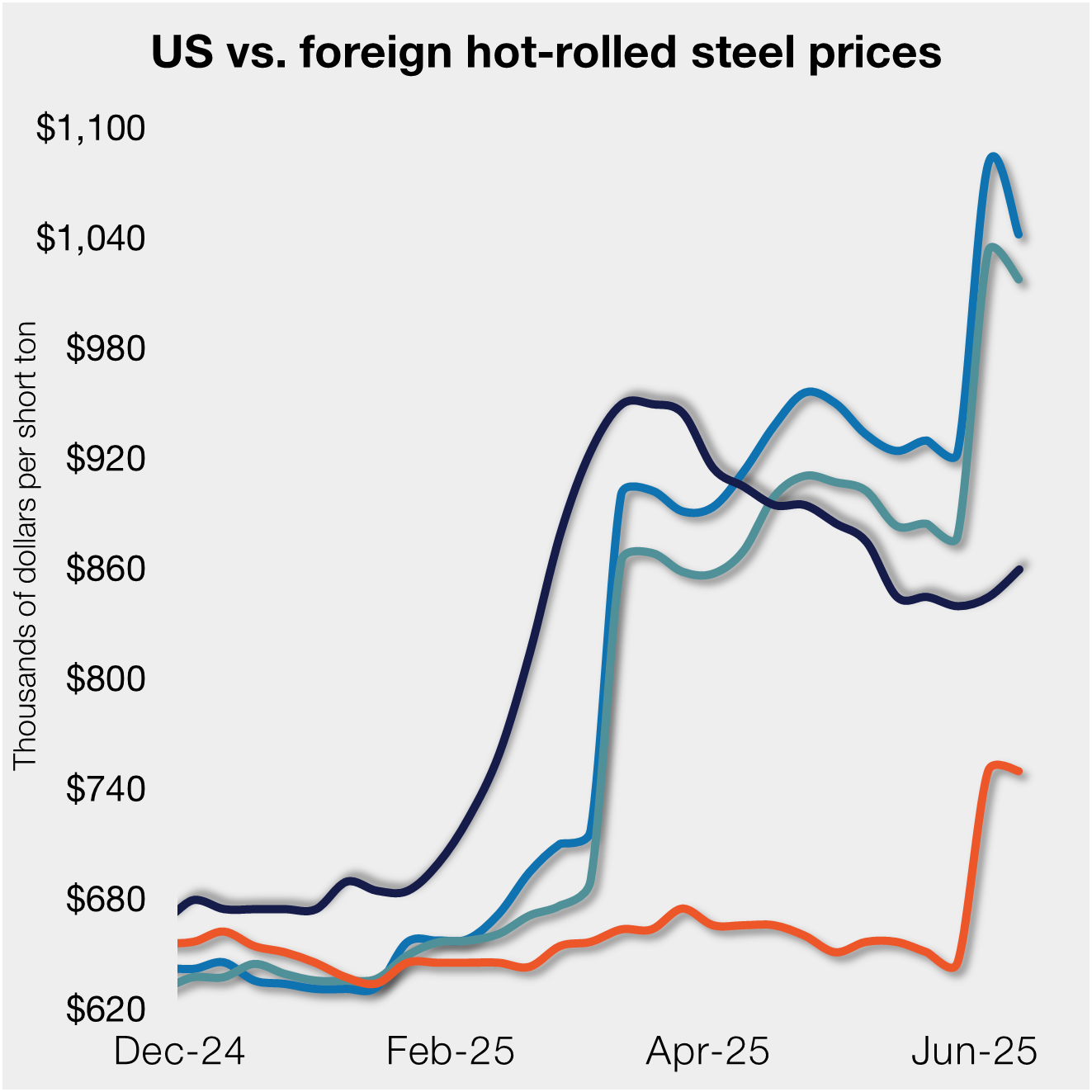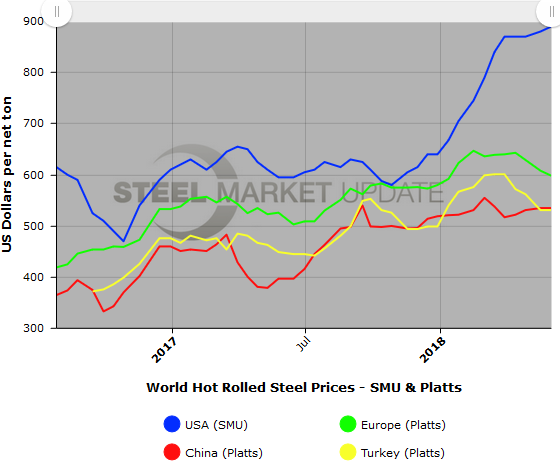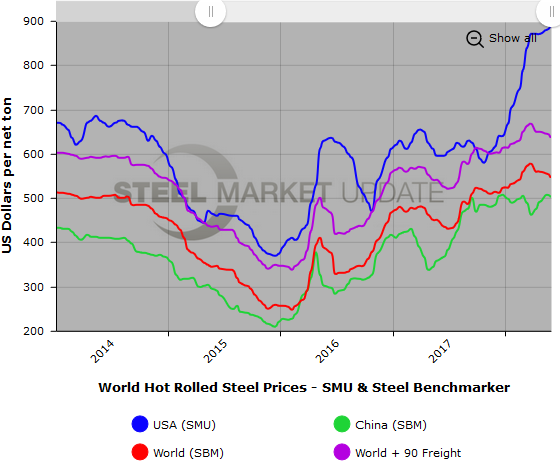International Steel Prices

Foreign vs. Domestic Hot Rolled Price Spread Remains High
Written by Brett Linton
May 31, 2018
The following calculation is used by Steel Market Update to identify the theoretical spread between foreign hot rolled steel import prices (delivered to USA ports) and domestic (USA) hot rolled coil prices (FOB Domestic mills). We want our readers to be aware that this is only a “theoretical” calculation as freight costs, trader margin and other costs can fluctuate, ultimately influencing the true market spread. We do not include the 25 percent tariff or any other unusual costs to the calculations we provide.
Our primary numbers for this analysis are from Platts as we compare European HRC export pricing (FOB Ruhr), Turkey HRC export pricing (FOB Turkey) and Chinese HRC export pricing (FOB Chinese port). Be aware that Chinese hot rolled pricing is not available to the U.S. market, so the Chinese spread is nothing more than an exercise in “what if.” SteelBenchmarker is the secondary data provider of foreign hot rolled coil prices and is noted further down in this article.
![]() SMU adds $90 per ton to these foreign prices taking into consideration freight costs, handling, trader margin, etc. This provides an approximate “CIF U.S. ports price” that can then be compared against the SMU U.S. hot rolled price average (FOB Mill), with the result being the spread (difference) between domestic and foreign hot rolled prices. As the price spread narrows, the competitiveness of imported steel into the United States is reduced. If the spread widens, then foreign steel becomes more attractive to U.S. flat rolled steel buyers. A positive spread means U.S. prices are higher than foreign prices, while a negative spread means U.S. prices are less than foreign prices. PLEASE NOTE: HRC prices are being affected by 25 percent tariffs, which brings new offers well above $800 per ton from the limited number of suppliers even quoting HRC.
SMU adds $90 per ton to these foreign prices taking into consideration freight costs, handling, trader margin, etc. This provides an approximate “CIF U.S. ports price” that can then be compared against the SMU U.S. hot rolled price average (FOB Mill), with the result being the spread (difference) between domestic and foreign hot rolled prices. As the price spread narrows, the competitiveness of imported steel into the United States is reduced. If the spread widens, then foreign steel becomes more attractive to U.S. flat rolled steel buyers. A positive spread means U.S. prices are higher than foreign prices, while a negative spread means U.S. prices are less than foreign prices. PLEASE NOTE: HRC prices are being affected by 25 percent tariffs, which brings new offers well above $800 per ton from the limited number of suppliers even quoting HRC.
As of Thursday, May 31, Platts published European HRC prices at $598 per net ton FOB Ruhr, down $10 from two weeks ago. Adding in $90 per ton for import costs, that puts the price at $688 per net ton from Europe delivered to the U.S. The latest Steel Market Update hot rolled price average is $890 per ton for domestic steel, up $10 per ton from our last world price comparison two weeks ago. That makes the price difference between European and U.S. HR prices +$202, up from +$182 seen two weeks ago. That means domestic HR is now theoretically $202 per ton more expensive than importing HR steel from Europe. This is now the highest price spread in our nearly three-year history. Back in mid-February, the prices were only $8 apart, and in late 2017 we saw the opposite where domestic steel was cheaper than European imports.
Chinese HRC prices were reported at $535 per net ton, unchanged from two weeks ago. Adding $90 in estimated import costs puts Chinese HRC prices at $625 per ton delivered (if Chinese mills were able to ship to the United States, which they are not). The spread between the Chinese and U.S. HR price is now +$265, up slightly from +$255 two weeks ago. So, if Chinese mills were able to ship HR to the U.S., it would theoretically cost $265 per ton less than buying domestic steel. This price difference has been increasing since September 2017, back when the spread was negative (meaning domestic HR would have been cheaper than Chinese imports). This spread has been in the $200s for eight weeks now.
Platts published Turkish export prices at $531 per net ton FOB Turkish port, unchanged from two weeks ago. Adding $90 in import costs, the Turkish HRC “to the U.S. ports” price is $621 per ton. This moves the spread between the Turkish and U.S. HR price from +$259 per ton two weeks ago to +$269 per ton today (now the highest spread seen in our limited history), meaning HR from the U.S. is theoretically $269 per ton more expensive than steel imported from Turkey. The Turkey/U.S. price spread has increased week by week since September/October 2017 when it dropped down to -$36 per ton (meaning domestic HR was $36 per ton cheaper than importing Turkish HR).
Freight is an important part of the final determination on whether to import foreign steel or buy from a domestic mill supplier. Domestic prices are referenced as FOB the producing mill, while foreign prices are FOB the Port (Houston, NOLA, Savannah, Los Angeles, Camden, etc.). Inland freight, from either a domestic mill or from the port, can dramatically impact the competitiveness of both domestic and foreign steel. When considering lead times, a buyer must take into consideration the momentum of pricing both domestically and in the world markets. If U.S. prices are rising, which they are at this time, thus the change in the spreads, then one must consider when the steel is to be delivered versus what is available at a firm price from foreign sources. In most circumstances (but not all), domestic steel will deliver faster than foreign steel ordered on the same day.
Below is a graph comparing the Platts foreign HR export prices against the SMU domestic HR average price. You will need to view the graph on our website to use its interactive features; you can do so by clicking here. If you need assistance with either logging in or navigating the website, please contact us at 800-432-3475 or info@SteelMarketUpdate.com.
SteelBenchmarker World Export Price
The SteelBenchmarker world export price for hot rolled bands is $546 per net ton FOB the port of export, according to data released by SteelBenchmarker on Monday, May 28. This is down $9 per ton from two weeks ago. Adding in $90 in estimated import costs, that puts prices around $636 per ton delivered to the U.S. As previously mentioned, the Steel Market Update hot rolled price average this week is $890 per ton.
Therefore, the theoretical spread between the SteelBenchmarker world HR export price and the SMU HR price is +$254 per ton, up $19 from two weeks ago, meaning imported HR is theoretically now $254 per ton cheaper than steel purchased domestically. As was the case two weeks ago, this is now the highest price spread in our seven-year history.
The latest price spread is $35-55 per ton higher than the average spread seen over the last few months. In late October 2017, the spread was the lowest seen in 2017 at -$27 per ton. This time last year, the spread was +$55 per ton, and hovered between $70 and $90 through the end of July. Prior to this year, the previous record high in our seven-year history was +$210 on June 27, 2016 (meaning domestic steel was theoretically $210 per ton more expensive than foreign steel), while the record low was -$70 in August 2011. The average spread for 2018 so far is +$170 per ton, while the average spread for 2017 was +$48 per ton.
We want to again remind our readers that the calculations shown above are “theoretical,” but in most markets are probably a good indicator of where you can expect to find offers being made.
Below is a graph comparing SteelBenchmarker world HR export prices against the SMU domestic HR average price. We also have included a line with the world price including freight and traders’ costs, which gives you a better indication of the true price spread. You will need to view the graph on our website to use its interactive features; you can do so by clicking here.

Brett Linton
Read more from Brett LintonLatest in International Steel Prices

Higher US CR prices inch closer to EU, Japanese tags
US cold-rolled (CR) coil prices continued to tick higher this week, while offshore markets were mixed.

Stacked S232 keeps US HR prices below EU
US hot-rolled coil prices crept up again this week but still trail imports from Europe.

Doubled S232 lifts EU, Japanese CR prices over US tags
US cold-rolled (CR) coil prices edged up again this week, and most offshore markets moved in the opposite direction. But the diverging price moves stateside vs. abroad did little to impact pricing trends. The bigger impact was from Section 232, which were doubled to 50% as of June 3. The higher tariffs have resulted in […]

CRU: Sheet demand remains weak, tariff changes again alter markets
Subdued demand has continued to weigh on steel sheet prices globally.

Higher S232 keeps US HR prices at a discount to EU
Domestic hot-rolled (HR) coil prices edged up marginally again this week, while offshore prices ticked down.


